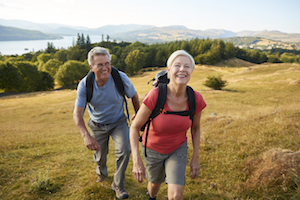The warm sun on your face, the sounds of nature, the feel of the wind in your hair. It’s been reported that spending time outdoors in green spaces can positively impact your mental health.
According to the National Park Service, hiking can provide mental and physical benefits, and what better time to hit the trails than at the end of summer and early fall?
Benefits of Hiking
Hiking can improve your physical and mental health. Specifically, it can:
- Build stronger muscles and bones
- Improve your sense of balance and heart health
- Calm anxiety
- Boost mood
- Improve your sensory perception
Hiking can even improve your relationships, because as the National Park Service explains: “hiking ranges in difficulty from an extremely challenging climb to a casual way of spending time outside, it’s a great way to strengthen the friendships or bonds you have with your companions.”
Hiking Safety Tips
Whether it’s your first time hitting the trail, or you’ve walked many winding dirt paths, keep these things in mind for safety:
Plan your hike: Before you begin, decide on the hiking trails you’d like to visit. When evaluating trails, consider whether you’d like to keep your hike to a day adventure or if you’d like to pack a tent and camp overnight. Keep your experience and the time you have available in mind when planning your hike.
Decide if you’d like to bring a companion: Hiking alone can be relaxing, however, as noted above, bringing a friend can have its benefits as well. Keep in mind that hiking solo can be dangerous if you were to get injured or need help, so if you’re planning to venture off trails and into the wilderness, it’s best to bring a companion or at least let someone know where you’ll be going and when you’re expected to return.
Check the weather: You’ve decided where you’ll hike and whether you’ll take a companion. Before you leave, check the weather conditions. Also, if you’re hiking in the warmer months, be prepared for brief afternoon thunderstorms.
Choose the proper footwear: Just like the right shoes can help reduce your risk for falls, the right shoes can help keep you comfortable and safe while hiking. When evaluating footwear, consider the trails you’ll use, what you’ll take – backpacking likely will require sturdier shoes — how stable your body is and your pace. Hiking footwear comes in a variety of options:
Hiking shoes: Give you proper support and safety and are best used for short hikes during the day or when you hike once in a while.
Hiking boots: Have more ankle support than shoes and are best for multi-day hikes.
Let someone know where you’re going: Even if you’re hiking with a companion, you should tell someone where you’ll be hiking and when you expect to return. Many hiking trails have poor or no cell phone service, so letting someone know where you’re going can be helpful if something were to go wrong.
Don’t forget water and snacks: You don’t want to become dehydrated while hiking. A supply of water and snacks will help keep you hydrated and fueled. If you run out of water, remember not to drink directly from a river or stream without some kind of filtration device.
Find a Hiking Trail Near You
You can find Ohio state parks near you here or enter your zip code into this trail finder to find hiking trails near you.











